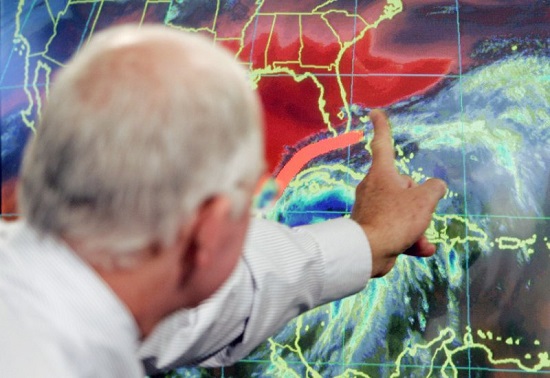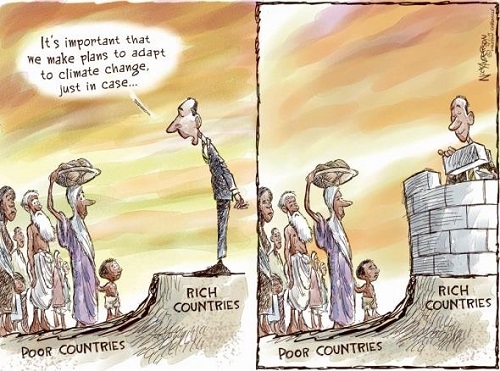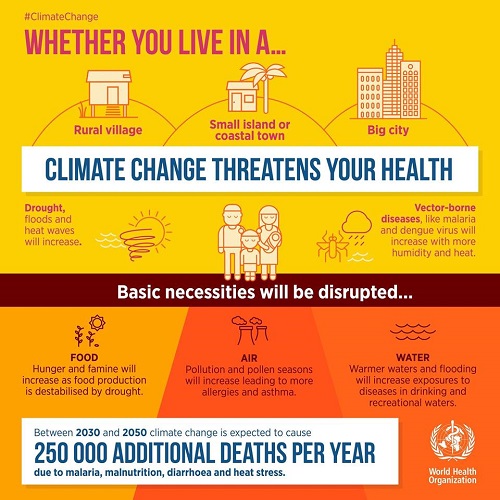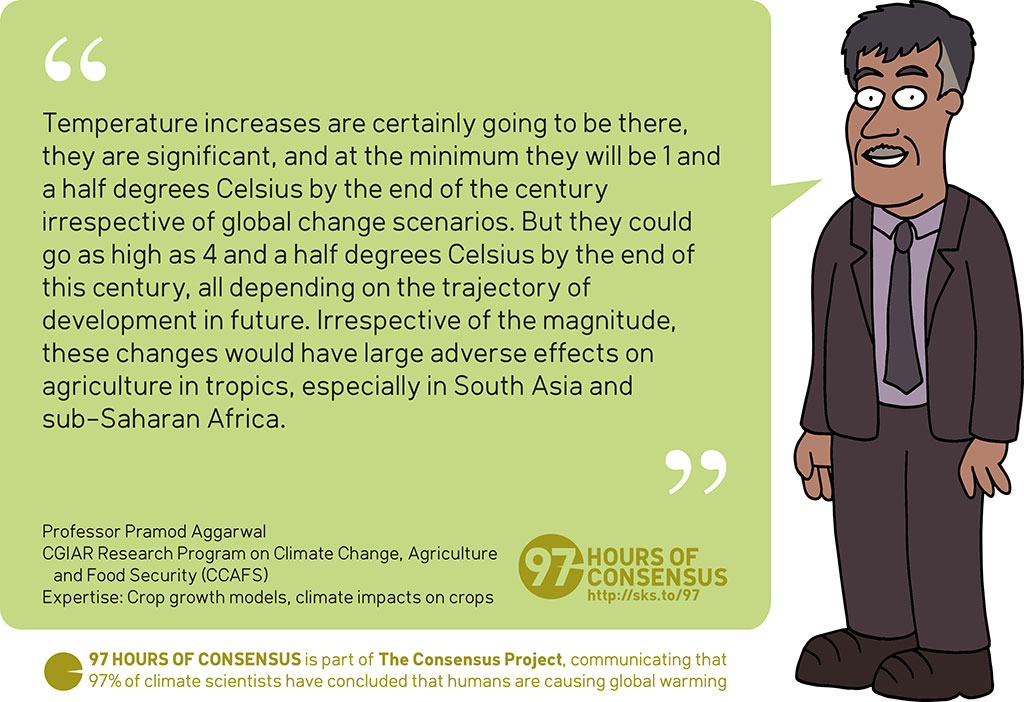2017 SkS Weekly Climate Change & Global Warming Digest #40
Posted on 8 October 2017 by John Hartz
Story of the Week... Editorial of the Week... El Niño/La Niña Update... Toon of the Week... SkS Spotlights... Video of the Week... Coming Soon on SkS... Poster of the Week... SkS Week in Review... 97 Hours of Consensus...
Story of the Week...
Science Says: Era of monster hurricanes roiling the Atlantic

In this Oct. 19, 2005 file photo, Max Mayfield, the former director of the hurricane center (now retired), draws a line showing one of the possible trajectories of Hurricane Wilma in Miami. It’s not just this year. The monster hurricanes Harvey, Irma, Maria, Jose and now Lee that have raged across the Atlantic are contributing to what appears to be the most active period for major storms on record. AP Photo/Alan Diaz)
It’s not just this year. The monster hurricanes Harvey, Irma, Maria, Jose and Lee that have raged across the Atlantic are contributing to what appears to be the most active period for major storms on record.
And the busiest part of hurricane season isn’t even over.
An analysis of 167 years of federal storm data by The Associated Press found that no 30-year period in history has seen this many major hurricanes, this many days of those whoppers spinning in the Atlantic, or this much overall energy generated by those powerful storms.
Science Says: Era of monster hurricanes roiling the Atlantic by Seth Borenstein, AP, Oct 5, 2017
Editorial of the Week...
Our Changing Climate Mind-Set
Climate images have never been able to convey our full planetary danger until now. The extraordinary recent four-punch sequence of hurricanes — Harvey, Irma, Jose and Maria — threatened the lives of millions of people, obliterated their homes and has raised doubts that some places will ever recover. The rest of us have a newly immediate sense of catastrophes of biblical proportions. As meaning-hungry creatures we search for explanations. No wonder some have embraced the apocalyptic narrative of total destruction by an angry deity. And no wonder that climate-change rejecters like President Trump have increasing difficulty defending their position.
Even before the hurricanes we had experienced a drumbeat of storms, floods, droughts and wildfires that rendered global warming not just a remote future danger but an immediate one. This fear was reinforced by the recent hurricanes, which provided imagery equivalent to the danger, imagery equivalent to nuclear disaster. When we viewed photographs and film of the annihilated cities of Hiroshima and Nagasaki, we sensed that the world could be ended by nuclear weapons. Now these hurricanes have conveyed a similar feeling of world-ending, having left whole islands, once alive in their beauty and commerce, in ruin.
But does this mean that we attribute this menace to global warming and to human contributions to that warming? My answer here is yes and no and yes again.
Our Changing Climate Mind-Set, Opinion by Robert Jay Lifton*, Sunday Review, New York Times, Oct 7, 2017
*Robert Jay Lifton, a psychiatrist, is the author, most recently, of “The Climate Swerve: Reflections on Mind, Hope, and Survival.”
El Niño/La Niña Update
GENEVA, Oct. 6 (Xinhua) — Large parts of the world may expect, for the second consecutive year, weak La Nina conditions that will influence the local weather in the next few months, according to an update from the World Meteorological Organization (WMO) on Friday.
The WMO says the upcoming La Nina conditions may develop with a probability of 50 to 55 percent in the final quarter of 2017, and that the La Nina event, if it does occur, will likely remain weak and conditions are expected to return to ENSO-neutral in the first quarter of 2018.
For a typical La Nina event to occur, it is essential for both ocean and atmosphere to display the associated characteristic features. The WMO says since August, sea surface temperatures in the eastern tropical Pacific have cooled rapidly, approaching La Nina levels, while atmospheric patterns have, however, largely remained ENSO-neutral.
World Meteorological Organization predicts upcoming weak La Nina conditions, Xinhuanet, Oct 8, 2017
Toon of the Week...

SkS Spotlights...
 GLOBAL CATHOLIC CLIMATE MOVEMENT
GLOBAL CATHOLIC CLIMATE MOVEMENT
The Global Catholic Climate Movement (GCCM) is a global network of 400+ member organizations and a community of thousands of Catholics like you, responding to the Pope’s call to action in the Laudato Si’ encyclical.
Click here to learn more about the GCCM.
Video of the Week...
Kerry Emanuel: 2017 Hurricanes a taste of Future
Climate scientist Kerry Emanuel describes physics behind expected increase in storm strength due to climate change. http://news.mit.edu/2017/kerry-emanuel-hurricanes-are-taste-future-0921
Video via Earth, Atmospheric and Planetary Sciences MIT https://www.youtube.com/user/EAPSweb/videos
Speaker: Kerry A. Emanuel, Cecil & Ida Green Professor of Atmospheric Science, Co-Director of the Lorenz Center
Natural disasters are the result of the interaction of a natural phenomenon with human beings and their built environments. Globally and in the U.S., large increases in coastal populations are causing corresponding increases in hurricane damage and these are now being compounded by rising sea levels and changing storm characteristics owing to anthropogenic climate change. In this talk, I will describe projections of changing hurricane activity over the rest of this century and what such projections tell us about how the probabilities of hurricanes like Harvey and Irma have already changed and are likely to continue to do so.
Kerry Emanuel: 2017 Hurricanes a taste of Future, YouTube Video/Climate State, Oct 7, 2017
Coming Soon on SkS...
- Trump’s plan to bail out failing fossil fuels with taxpayer subsidies is perverse (Dana)
- Analysis: How well have climate models projected global warming? (Zeke Hausfather)
- Unstoppable renewable energy trends (John Abraham)
- SkS Analogy 10 - Bathtubs and Budgets (Evan)
- New research this week (Ari)
- 2017 SkS Weekly Climate Change & Global Warming News Roundup (John Hartz)
- 2017 SkS Weekly Climate Change & Global Waming Digest (John Hartz)
Poster of the Week...

SkS Week in Review...
- 2017 SkS Weekly Climate Change & Global Warming News Roundup #40 by John Hartz
- New research, September 25 - October 1, 2017 by Ari Jokimäki
- Factcheck: Climate models have not ‘exaggerated’ global warming by Zeke Hausfather (Carbon Brief)
- Global climate impacts of a potential volcanic eruption of Mount Agung Guest Post by Flavio Lehner & John Fasullo
- Inside the Experiment: Abrupt Change and Ice Cores Video by Peter Sinclair (Yale Climate Connections)
- Why the 97% climate consensus is important by Dana Nuccitelli, John Cook, Sander van der Linden, Tony Leiserowitz & Ed Maibach (Climate Consensus - the 97%, Guardian)
- 2017 SkS Weekly Climate Change & Global Warming Digest #39 by John Hartz
97 Hours of Consensus...
































 Arguments
Arguments






























The article presents evidence that atlantic hurricane intensity has essentially increased, (paraphrasing) but says scientists arent sure, because the data on intensity of older hurricanes is poor, and numbers of hurricanes in the past were undercounted.
I dont see why early records of intensity would be so inaccurate. The devices that measure wind speed, anemometers have been around for well over 100 years.
If they missed counting numbers of some older hurricanes its likely the ones they did count would have a reasonably representitive intensity level. It appears the scientists are being incredibly cautious maybe excessively so.
Anyway regardless of these various issues on poor data, I'm very inclined to believe IPCC projections that intensity will increase, because the science on it is so strong.
Compare all this to Pacific tropical cyclones. They have increased in intensity and the research appears much more definitive than atlantic hurricanes. Just one example:
www.smithsonianmag.com/science-nature/warmer-waters-are-making-pacific-typhoons-stronger-180955443/
There doesnt appear to be the same doubt about early records for some reason. And they attribute the increase in intensity more directly to climate change rather than some 30 year ocean cycle, although with some caveats.
I tend to agree that at least some scientists are tending to be overly cautious. The article does state, however, that "The Associated Press looked at all major hurricanes — not just the small fraction that hit the U.S...." One of Roger Pielke Jr's favourite tricks is to restrict his analysis to only hurricanes that hit the U.S.
Although measuring wind speed is old technology, you need to be able to get an anemometer in the way of the storm, and that is difficult over water. Much modern hurricane data comes from aircraft flights, and knowing the hurricanes exist is more easily accomplished with satellites.
A while back Tamino had an interesting post on an alternative approach. Instead of looking for wind data, the paper Tamino referenced looked at storm surge data in tidal records. These could record the effect of hurricanes that did not reach land. At Tamino's there is a comment that points back to this SkS post, where the auhtor of the paper commented.